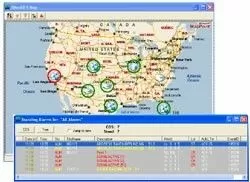Check out our White Paper Series!
A complete library of helpful advice and survival guides for every aspect of system monitoring and control.
1-800-693-0351
Have a specific question? Ask our team of expert engineers and get a specific answer!
Sign up for the next DPS Factory Training!

Whether you're new to our equipment or you've used it for years, DPS factory training is the best way to get more from your monitoring.
Reserve Your Seat TodayI was at the 2024 New Orleans Tradeshow two weeks ago and I took notes on all the interactions that we had. A lot of people had amazing questions that I thought would be beneficial if turned into a blog to elaborate further on them.
When talking about SCADA (Supervisory Control and Data Acquisition) systems, one of the main advantages that always comes up is its flexibility. But what exactly does that mean? And how can it be implemented in any industrial application?
Let's take a look at all the different scenarios that we can cater to.
The first person to approach me was a gentleman who made large PDUs (Power Distribution Units).
A PDU is used in environments where you need to manage and distribute electrical power to various equipment like servers, storage rooms, etc.

One example of switched rack PDUs is the Remote Power Controller 100 from DPS Telecom.
He wanted to know if he could load his Linux software on DPS Telecom Hardware, and if he could use his CPU.
The DPS Telecom T/MON already uses a flavor of Linux. However, DPS Telecom specializes in customizing our client's form factors and overall system configurations.
Putting Linux software on a Linux computer such as any DPS hardware that supports it is entirely possible. We know every client has different needs. To be a good manufacturer, we must offer flexible solutions to meet those needs. If you tell us what you want to accomplish, we will be able to find a solution together.
As a general overview, here are the steps to migrating your software onto SCADA hardware in general:
This client makes and sells liquid cooling systems for power utilities. He wanted to monitor GIS systems on company premises. The main problem is that he doesn't have access to a network to install and monitor the GIS.

My client also told me that after reviewing his logs, he realized that he recently had a failure that could have been seen days earlier if he had proper monitoring.
He told me that the torque increases as the rubber belts in his system cool down in cold places like Wisconsin.
The solution that I proposed to my client was a NetGuardian RTU in a small cabinet with sensors. I also recommended an analog threshold alerting mechanism, along with a torque sensor.
Here is a generic sequence of how we could monitor his rubber belt torque:
My client contacted me later because he was wondering if I could set up a T/MON (Alarm Master) to the cloud, and I let him know that he could hook up a T/MON to the cloud via SNMP to the cloud manager.
A potential client needed a smaller RTU such as a NetGuardian DIN with 16 discrete inputs to monitor his generators.
We talked about how the NetGuardian DIN can connect with MultiTech's rCell Modem so my client can get SMS texts. You can send SMS messages from your DIN instead of relying on an email-to-SMS gateway.
A Text-2-Cell via email gateway is useful if you don't have a cellular modem like the MultiTech rCell. However, you risk the loss of SMS capabilities if the provider of a certain network goes offline.
Form factors are a common concern. Everyone has a different infrastructure that requires different mounting capabilities. My client wanted five +24vdc remote telemetry units with 8 analog inputs that accept 4-20mA.
The data would be communicated over Modbus protocol to his SCADA alarm master. In addition, my client specified that he wanted wall-mounted RTUs.
Although DPS Telecom already has a wide variety of NetGuardians (RTUs) with varying form factors, we are still willing to offer you application-specific customization to fit your needs.
A client approached me that had multiple microgrid system projects under development. If a grid system is how an entire city generates and delivers power, a microgrid system is a self-sufficient energy system that improves the environmental footprint of a small community.
this can often mean a college campus, a business complex, a hospital complex, etc. A microgrid is a local and independent form of energy. This is beneficial when you have city-wide power outages and don't want to be affected by them.
When you have an independent energy infrastructure like this, you will need full visibility over the processes and health of your facilities. This is possible with SCADA.
With SCADA you can:
DPS Telecom has engineers and other technical experts on hand who have helped build the company with many years in the industry. We offer detailed guides to help clients understand our products and learn how to take care of them on their own.
DPS Telecom offers a "made in the USA" manufacturing approach, meaning everything can be customized and delivered promptly to our clients. This guarantees our customers the following:
The question of whether we "can" do something or not doesn't resonate with our motto. Instead, we like the question of "how" we are going to do something. DPS Telecom wants you to treat it like your own personal engineer
If you have any projects that you think we could be of help in, or if you have any further questions on the topics covered in this article, please feel free to reach out.
Even if we can't find a solution together, I will do my best to point you in the right direction.
Whatever questions you have, give me a call at 1-800-693-0351. You can also send a quick email to sales@dpstele.com

Ziad Alezabi
Ziad Alezabi is a Application Documentarian at DPS Telecom. He reviews successful DPS client projects and reports on the best practices that you can use to successfully reach your own project goals.